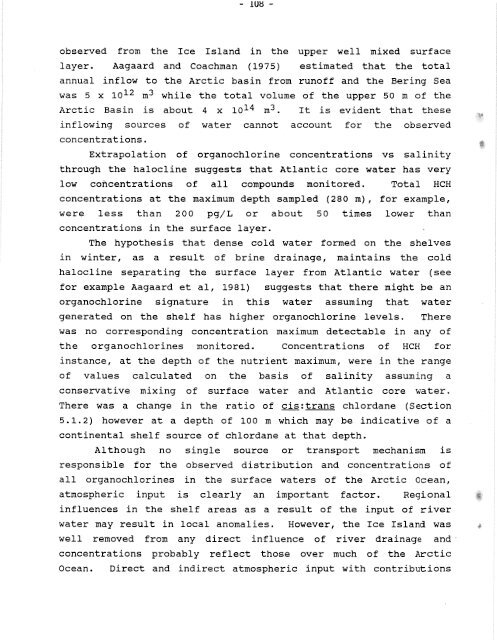Distribution of Chlorinated Hydrocarbon Pesticides and PCBs in the ...
Distribution of Chlorinated Hydrocarbon Pesticides and PCBs in the ...
Distribution of Chlorinated Hydrocarbon Pesticides and PCBs in the ...
Create successful ePaper yourself
Turn your PDF publications into a flip-book with our unique Google optimized e-Paper software.
observed from <strong>the</strong> Ice Isl<strong>and</strong> <strong>in</strong> <strong>the</strong> upper well mixed surface<br />
layer. Aagaard <strong>and</strong> Coachman (1975) estimated that <strong>the</strong> total<br />
annual <strong>in</strong>flow to <strong>the</strong> Arctic bas<strong>in</strong> from run<strong>of</strong>f <strong>and</strong> <strong>the</strong> Ber<strong>in</strong>g Sea<br />
was 5 x 1012 m3 while <strong>the</strong> total volume <strong>of</strong> <strong>the</strong> upper 50 m <strong>of</strong> <strong>the</strong><br />
Arctic Bas<strong>in</strong> is about 4 x lo1* m3. It is evident that <strong>the</strong>se<br />
<strong>in</strong>flow<strong>in</strong>g sources <strong>of</strong> water cannot account for <strong>the</strong> observed<br />
concentrations.<br />
Extrapolation <strong>of</strong> organochlor<strong>in</strong>e concentrations vs sal<strong>in</strong>ity<br />
through <strong>the</strong> halocl<strong>in</strong>e suggests that Atlantic core water has very<br />
low concentrations <strong>of</strong> all compounds monitored. Total HCH<br />
concentrations at <strong>the</strong> maximum depth sampled (280 m) , for example,<br />
were less than 200 pg/L or about 50 times lower than<br />
concentrations <strong>in</strong> <strong>the</strong> surface layer.<br />
The hypo<strong>the</strong>sis that dense cold water formed on <strong>the</strong> shelves<br />
<strong>in</strong> w<strong>in</strong>ter, as a result <strong>of</strong> br<strong>in</strong>e dra<strong>in</strong>age, ma<strong>in</strong>ta<strong>in</strong>s <strong>the</strong> cold<br />
halocl<strong>in</strong>e separat<strong>in</strong>g <strong>the</strong> surface layer from Atlantic water (see<br />
for example Aagaard et all 1981) suggests that <strong>the</strong>re might be an<br />
organochlor<strong>in</strong>e signature <strong>in</strong> this water assum<strong>in</strong>g that water<br />
generated on <strong>the</strong> shelf has higher organochlor<strong>in</strong>e levels. There<br />
was no correspond<strong>in</strong>g concentration maximum detectable <strong>in</strong> any <strong>of</strong><br />
<strong>the</strong> organochlor<strong>in</strong>es monitored. Concentrations <strong>of</strong> HCH for<br />
<strong>in</strong>stance, at <strong>the</strong> depth <strong>of</strong> <strong>the</strong> nutrient maximum, were <strong>in</strong> <strong>the</strong> range<br />
<strong>of</strong> values calculated on <strong>the</strong> basis <strong>of</strong> sal<strong>in</strong>ity assum<strong>in</strong>g a<br />
conservative mix<strong>in</strong>g <strong>of</strong> surface water <strong>and</strong> Atlantic core water.<br />
There was a change <strong>in</strong> <strong>the</strong> ratio <strong>of</strong> &:trans chlordane (Section<br />
5.1.2) however at a depth <strong>of</strong> 100 m which may be <strong>in</strong>dicative <strong>of</strong> a<br />
cont<strong>in</strong>ental shelf source <strong>of</strong> chlordane at that depth.<br />
Although no s<strong>in</strong>gle source or transport mechanism is<br />
responsible for <strong>the</strong> observed distribution <strong>and</strong> concentrations <strong>of</strong><br />
all organochlor<strong>in</strong>es <strong>in</strong> <strong>the</strong> surface waters <strong>of</strong> <strong>the</strong> Arctic Ocean,<br />
atmospheric <strong>in</strong>put is clearly an important factor. Regional<br />
<strong>in</strong>fluences <strong>in</strong> <strong>the</strong> shelf areas as a result <strong>of</strong> <strong>the</strong> <strong>in</strong>put <strong>of</strong> river<br />
water may result <strong>in</strong> local anomalies. However, <strong>the</strong> Ice Isl<strong>and</strong> was<br />
well removed from any direct <strong>in</strong>fluence <strong>of</strong> river dra<strong>in</strong>age <strong>and</strong><br />
concentrations probably reflect those over much <strong>of</strong> <strong>the</strong> Arctic<br />
Ocean. Direct <strong>and</strong> <strong>in</strong>direct atmospheric <strong>in</strong>put with contributions

















